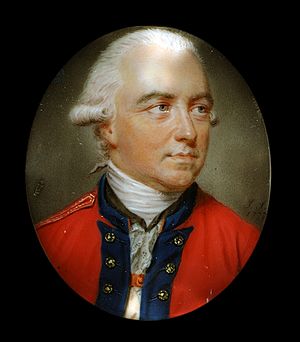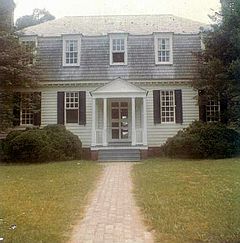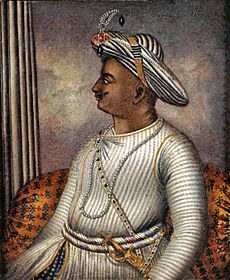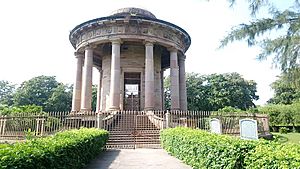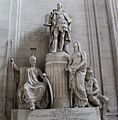Charles Cornwallis, 1st Marquess Cornwallis facts for kids
Quick facts for kids
General His Excellency The Most Honourable
The Marquess Cornwallis
|
|
|---|---|
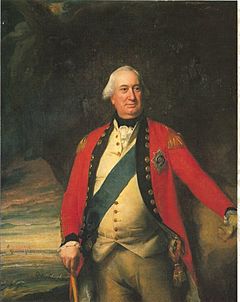
Portrait by John Singleton Copley, c. 1795
|
|
| Governor-General of the Presidency of Fort William |
|
| In office 30 July 1805 – 5 October 1805 |
|
| Monarch | George III |
| Prime Minister | William Pitt the Younger |
| Preceded by | The Marquess Wellesley |
| Succeeded by | Sir George Barlow, Bt As Acting Governor-General |
| In office 12 September 1786 – 28 October 1793 |
|
| Monarch | George III |
| Prime Minister | William Pitt the Younger |
| Preceded by | Sir John Macpherson, Bt As Acting Governor-General |
| Succeeded by | Sir John Shore |
| Lord Lieutenant of Ireland | |
| In office 14 June 1798 – 27 April 1801 |
|
| Monarch | George III |
| Prime Minister | William Pitt the Younger |
| Preceded by | The Earl Camden |
| Succeeded by | The Earl Hardwicke |
| Member of Parliament for Eye |
|
| In office 1760–1762 |
|
| Preceded by | Henry Townshend |
| Succeeded by | Richard Burton |
| Personal details | |
| Born |
Charles Edward Cornwallis V
31 December 1738 Grosvenor Square, Mayfair, London, England, Great Britain (present-day United Kingdom) |
| Died | 5 October 1805 (aged 66) Gauspur, Kingdom of Kashi-Benares (present-day Ghazipur, Uttar Pradesh, India) |
| Spouse |
Jemima Tullekin Jones
(m. 1768; died 1779) |
| Children | 2, incl. Charles |
| Alma mater | Eton College Clare College, Cambridge |
| Occupation | Military officer, official |
| Awards | Knight Companion of The Most Noble Order of the Garter |
| Signature | |
| Military service | |
| Allegiance | |
| Branch/service | British Army |
| Years of service | 1757–1805 |
| Rank | General |
| Commands | India Ireland South-East England |
| Battles/wars | Seven Years' War American War of Independence Third Mysore War Irish Rebellion of 1798 Anti-invasion preparations |
Charles Cornwallis, 1st Marquess Cornwallis (1738–1805) was a British general and important government official. He is most famous for his role in the American War of Independence. He was a leading British general during this conflict. His surrender at the siege of Yorktown in 1781 effectively ended the major fighting in North America.
After the war, Cornwallis continued his career. He served as a governor and military leader in Ireland. There, he helped bring about the Act of Union, which joined Great Britain and Ireland. He also worked in India as Governor-General. In India, he introduced important changes, including the Cornwallis Code and the Permanent Settlement.
Contents
Who was Charles Cornwallis?
Charles Cornwallis was born on December 31, 1738, in London, England. His family was very important and wealthy. He was the eldest son of Charles Cornwallis, 5th Baron Cornwallis. His mother, Elizabeth, came from another influential family.
He went to Eton College and Cambridge University. These were top schools for young men from important families. In 1762, when his father died, Charles became the 2nd Earl Cornwallis. This meant he joined the House of Lords, a part of the British Parliament.
Early Military Career
Cornwallis joined the army in 1757. He first served as an Ensign in the 1st Foot Guards. He also studied military tactics in Turin, Italy.
His first major military experience was in the Seven Years' War. This was a big war fought around the world. In 1759, he fought in the Battle of Minden. This battle stopped a French invasion of Hanover. He was promoted to Captain and later to Lieutenant-Colonel. He was known for being brave in battles like Battle of Villinghausen in 1761.
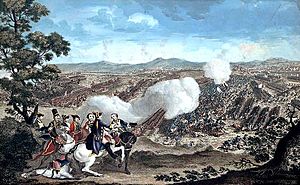
Cornwallis and Politics
In 1760, before becoming Earl, Cornwallis was elected to the House of Commons. He was a Whig, a political group that supported more freedom.
He was one of only five members of the House of Lords who voted against the Stamp Act in 1765. This act taxed the American colonies. Cornwallis felt sympathy for the colonists. He continued to support them during the growing tensions that led to the American War of Independence.
In 1768, he married Jemima Tullekin Jones. They had two children, Mary and Charles. Their marriage was very happy. Sadly, Jemima died in 1779.
Role in the American War of Independence
Even though he had supported the colonists, Cornwallis chose to serve in the British army when the war began. He was promoted to Major General in 1775. He was eager to fight and suggested an expedition to the southern colonies.
Early Battles in America
In 1776, Cornwallis served under General Sir Henry Clinton. He took part in the failed siege of Charleston. Then, he went to New York City and fought in the campaign for New York.
Cornwallis often led the advance forces. His troops were at the front during the Battle of Long Island. He also chased George Washington's army across New Jersey. General William Howe praised Cornwallis for his success.
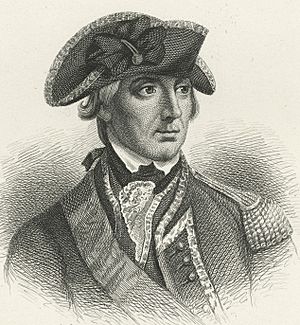
In January 1777, Cornwallis tried to stop Washington after the surprise attack on Trenton. He gathered British forces and moved towards Trenton. However, Washington's army slipped away during the night. They then attacked the British at Princeton. Cornwallis spent the winter in New York and New Jersey, fighting small battles.
He continued to serve under General Howe in the Philadelphia campaign. Cornwallis led important attacks at Brandywine and Germantown. After a period of leave, he returned to America in 1778. By then, Clinton had replaced Howe as commander.
When France joined the war, the British decided to leave Philadelphia. Cornwallis led the rear guard during the march back to New York City. He played a key role in the Battle of Monmouth.
Fighting in the Southern Colonies
Cornwallis returned to America in July 1779. He became the main commander of the British "Southern strategy." This plan aimed to invade the southern colonies. The British believed many Loyalists (people loyal to Britain) would help them there.
In 1780, Clinton and Cornwallis led a large force south. They successfully captured Charleston after a siege. After this victory, Clinton returned to New York, leaving Cornwallis in charge of the southern forces.
Cornwallis set up outposts in South Carolina. However, keeping supplies and communication lines open was difficult. Patriot (American rebel) groups constantly attacked British units and supply routes.
In August 1780, Cornwallis's army defeated a larger American force at the Battle of Camden. This was a big win for the British. It helped clear South Carolina of American Continental forces.
Cornwallis then moved into North Carolina. However, his Loyalist support was weakened when American forces defeated them at Kings Mountain and Cowpens. He then fought General Nathanael Greene's army at Guilford Court House. Cornwallis won, but his army suffered heavy losses. This kind of victory, where you win but lose a lot, is called a Pyrrhic victory.
Cornwallis moved his tired army to Wilmington on the coast for supplies. He then decided to join forces with another British army in Virginia.
The Virginia Campaign and Yorktown
In Virginia, Cornwallis took command of the British forces. He raided the countryside, destroying American military and economic targets. General Washington sent the Marquis de Lafayette to defend Virginia. Lafayette avoided major battles while gathering more troops.
Cornwallis received orders from Clinton to build a fortified naval base on the Virginia Peninsula. He chose a spot near Yorktown. This decision put him in a dangerous position.
When the French fleet arrived under the Comte de Grasse, Cornwallis was cut off. Washington's combined French-American army also arrived. After the British navy was defeated at the Battle of the Chesapeake, Cornwallis's situation became impossible.
He surrendered his army to General Washington and the French commander, the Comte de Rochambeau, on October 19, 1781. Cornwallis claimed to be ill and sent another officer to surrender his sword. This surrender marked the end of major fighting in the American War of Independence.
Back in Britain
Cornwallis returned to Britain in 1782. His surrender at Yorktown did not end his career. He still had the trust of King George III and the government.
In 1785, he was sent to Prussia as an ambassador. He met his old opponent Lafayette there.
Governor-General of India
In 1786, Cornwallis was made a Knight of the Order of the Garter. The same year, he became Governor-General and commander-in-chief in India.
Important Reforms in India
Cornwallis made many important changes in India. He reformed how the East India Company operated. He stopped company employees from trading for themselves. Instead, he increased their salaries. He also promoted people based on their skills, not just their connections.
He improved the justice system. He had Muslim and Hindu laws translated into English. In 1793, he introduced the Cornwallis Code. This code set up new civil and criminal laws. It also created a system where British officials were at the top of the legal system.
Cornwallis also tried to help the poorer people. He passed laws to protect local weavers from unfair practices. He outlawed child slavery. He also set up a Sanskrit college for Hindus in 1791. He created a mint in Calcutta to provide a reliable currency.
A major reform was the Permanent Settlement. This changed how taxes were collected from landowners (called zamindars). The tax was based on the land's value, not just its produce. Cornwallis hoped this would encourage landowners to improve their land. However, it often left peasants at the mercy of the landowners.
War with Tipu Sultan
Cornwallis tried to avoid wars in India. However, he was drawn into a conflict with Tipu Sultan, the ruler of Mysore. Tipu Sultan had invaded a British ally, the Kingdom of Travancore.
Cornwallis personally took command of the British forces in 1791. He formed alliances with other Indian states. He marched towards Tipu's capital, Seringapatam. After a siege, Tipu Sultan asked for peace.
The Treaty of Seringapatam was signed in 1792. Tipu had to give up half of his territory. As a guarantee, two of his sons were given to Cornwallis as hostages. For his success, Cornwallis was made Marquess Cornwallis in 1792. He returned to England in 1793.
Lord Lieutenant of Ireland
In 1798, Cornwallis was appointed Lord Lieutenant of Ireland and Commander-in-Chief. This happened because of the Irish Rebellion of 1798. He oversaw the defeat of the Irish rebels and a French invasion force.
He also played a key role in passing the Act of Union in 1800. This act joined Great Britain and Ireland to form the United Kingdom of Great Britain and Ireland. Cornwallis found this process difficult because it involved a lot of political deals. He resigned in 1801.
Treaty of Amiens
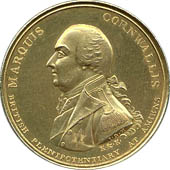
After returning to Britain, Cornwallis was sent to France. His task was to finalize peace terms with Bonaparte. These negotiations led to the Treaty of Amiens, which Cornwallis signed in 1802. This treaty ended the War of the Second Coalition. However, the peace did not last long, and war broke out again in 1803.
Death and Legacy
In 1805, Cornwallis was reappointed Governor-General of India. He arrived in India in July 1805. He died on October 5, 1805, from a fever in Ghazipur, India. He was buried there, overlooking the Ganges River. A memorial to him stands in St Paul's Cathedral in London.
Cornwallis is remembered for his military leadership and his reforms in India. Fort Cornwallis in Penang, Malaysia, is named after him. Statues of Cornwallis can be found in London, Chennai (India), and Kolkata (India).
Images for kids
-
A political cartoon by James Gillray making fun of Cornwallis after his retreat from Seringapatam
-
A statue of Cornwallis by John Bacon and John Bacon, Jr. The statue now stands in the Victoria Memorial in Kolkata.
-
General Lord Cornwallis receiving Tipoo Sultan's sons as hostages, by Robert Home, c. 1793
See also
 In Spanish: Charles Cornwallis para niños
In Spanish: Charles Cornwallis para niños


